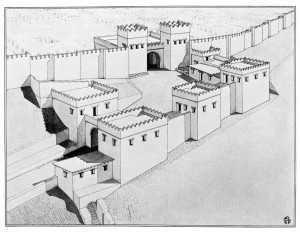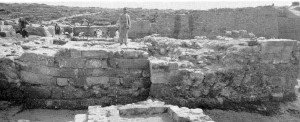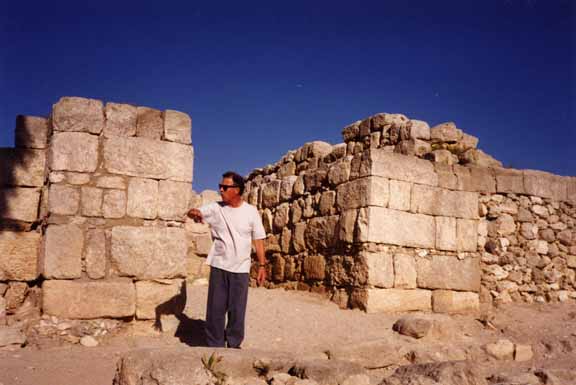Editor’s Note: The “Solomonic” gates at Hazor, Gezer and Megiddo have long been controversial for their apparent confirmation of Biblical accounts. Below, Prof. David Ussishkin, the excavator of Lachish and Megiddo, argues that the six-chambered gate structure at Megiddo cannot be dated to the tenth century and the reign of Solomon. What is the proper relationship of archaeology and the Bible, and which takes precedence for historical reconstruction?
The So-Called “Solomonic” City-gate at Megiddo
By: David Ussishkin
Following the discovery in 1958 of the six-chambered gate at Hazor, Yigael Yadin published his famous concept equating the six-chambered gates of Hazor, Megiddo and Gezer with 1 Kings 9:15 which states that Solomon built those three cities. This equation clinched the attribution of the Megiddo gate to the reign of Solomon.
Megiddo Stratum VA-IVB, the administrative city characterized by palaces, was assigned by Yadin to the reign of Solomon, while Stratum IVA, the overlying city of stables, was assigned by him to the Omride kings. While no city-wall of Stratum VA-IVB was discerned in the Chicago excavations, a massive stone city-wall – City-Wall 325 – surrounded the later Stratum IVA city. Based on the above equation and believing that the gate must be Solomonic in date, Yadin suggested that the six-chambered gate had been built in Stratum VA-IVB, the Solomonic city. He assumed that a casemate city-wall which had not been discerned by the University of Chicago researchers must have surrounded the Stratum VA-IVB city, and that the gate had been connected to it.
Based on the Chicago excavation report, Yohanan Aharoni showed in 1972 that the six-chambered gate was connected to the later Stratum IVA City-Wall 325. Accepting the concept that 1 Kings 9:15 dated the gate to the reign of Solomon, he assigned Stratum IVA to the same period, and the earlier Stratum VA-IVB to the reign of David. Yadin now suggested that the gate must have had two phases (characterized by two floor levels) in its history: The earlier Solomonic phase, in which the gate was connected to the assumed casemate city-wall of Stratum VA-IVB; and a later phase, labeled by Yadin Stratum IVAI, in which the gate was connected to City-Wall 325 of Stratum IVA. Yadin’s biblical and stratigraphic concepts are accepted today by many scholars.

Reconstruction of the gate complex. The so-called “Solomonic” six-chambered inner gate is at the top (after Megiddo II: Fig. 107).
In 1980, I published a detailed article on the so-called “Solomonic” gate and its date. After thirty-three years, including twenty years of renewed excavations at Megiddo, I still hold to my views.
I believe that the methodological approach adopted by Yadin and his followers is incorrect. The starting point of the discussion on the gate and its date should be the stratigraphic evidence from Megiddo, rather than comparable gates from other sites and biblical texts. Important as they are, they come second in any evaluation.
Analysis of the excavation data, uncovered and published by the Chicago researchers, leads to a clear, unequivocal picture. The six-chambered gate formed the inner gatehouse of a larger complex which included an outer gate, an inner gate and a courtyard between them.
The excavated remains of the six-chambered gate form the massive foundation structure of the building. The gate had a single floor in its history; the lower floor discerned by Yadin in fact belonged to an earlier gate structure. City-Wall 325 adjoined the gate towers, and it is clear that both wall and towers were concurrently built.

The façade of the six-chambered gate during excavation. The man stands on the right-hand tower; the adjoining City-Wall 325 can be seen at right (after Megiddo II: Fig. 109).
An earlier casemate wall was not discerned here.
In summary, the so-called “Solomonic” city-gate belonged to the stable city of Stratum IVA, dated much later than Solomon, probably to the Iron IIb period, to the 8th century BCE.
And what about biblical historiography? In my view the date of the Megiddo gate has hardly any bearing on the grave issues related to understanding the nature of Solomon’s kingdom and the interpretation of the biblical texts. These questions have to be evaluated separately by biblical scholars, rather than by archaeologists.
David Ussishkin is Professor Emeritus of Archaeology at Tel Aviv University.
If you liked this article please sign up to receive The Ancient Near East Today via email! It’s our FREE monthly email newsletter. The articles will be delivered straight to your inbox, along with links to news, discoveries, and resources about the Ancient Near East. Just go here to sign up.
All content provided on this blog is for informational purposes only. The American Schools of Oriental Research (ASOR) makes no representations as to the accuracy or completeness of any information on this blog or found by following any link on this blog. ASOR will not be liable for any errors or omissions in this information. ASOR will not be liable for any losses, injuries, or damages from the display or use of this information. The opinions expressed by Bloggers and those providing comments are theirs alone, and do not reflect the opinions of ASOR or any employee thereof.

Which takes precedent? How about the physical proof? Because if your theory doesn't hold up in the light of physical proof, your theory is wrong.
In this article you refer to an earlier stratum floor "the lower floor discerned by Yadin in fact belonged to an earlier gate structure."
If this in fact is an earlier gate structure to what period would this belong? Would that maybe be another factor in the Solomonic dating?
I was once told that when it came to the casemate wall the Chicago researchers when excavating in the gate area disconnected the gate from the wall/s before noting which wall/s made a connection to the Gate. Is this the case and if it is how then does one explain away the Solomonic connection?
Pingback: Livius Nieuwsbrief / September | Mainzer Beobachter
Pingback: Aantekeningen bij de Bijbel · Livius Nieuwsbrief / September
How about you relax and accept that the six chambered gate is the six chambered gate of Solomon. Do you see any other six chambered gates at these sites just popping up? Believe the Bible.
Holy crap, would you need to see Noah in the Ark if it was found on Mount Ararat to believe it was his?